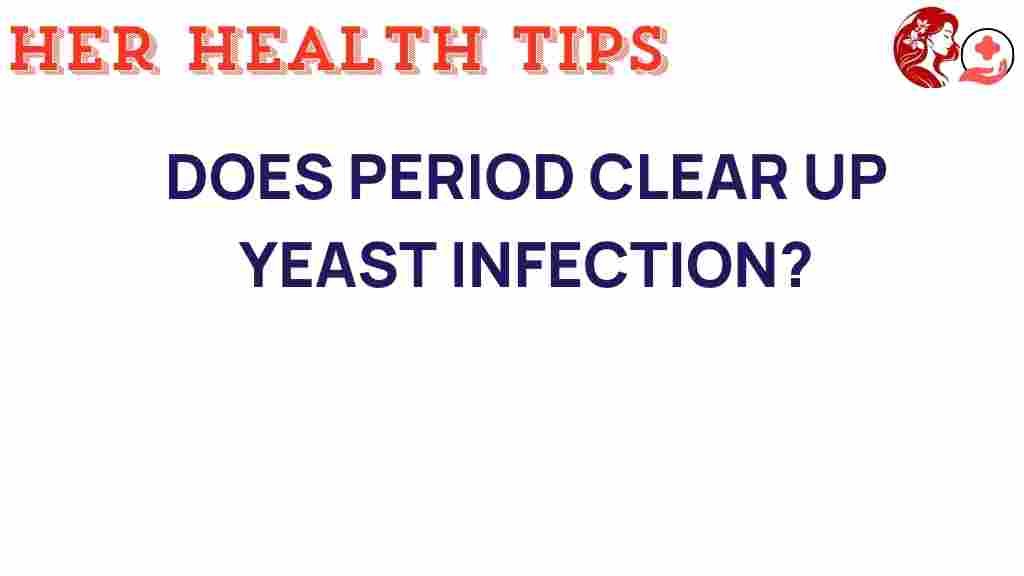The Surprising Connection: Does Your Period Clear Up Yeast Infections?
Yeast infections are a common concern for many women, often leading to discomfort and frustration. As many women experience their menstrual cycle, it raises the question: does your period clear up yeast infections? Understanding the relationship between hormonal changes, menstrual cycles, and vaginal health can provide valuable insights into managing yeast infections effectively. In this article, we’ll explore the connection between your period and yeast infections, the role of hormonal changes, and some natural remedies for treatment.
Understanding Yeast Infections
A yeast infection, also known as candidiasis, is caused by an overgrowth of the fungus Candida, which is normally present in small amounts in the vagina. When the balance of bacteria and yeast is disrupted, it can lead to an infection. Common symptoms include:
- Itching and irritation in the vaginal area
- Thick, white discharge resembling cottage cheese
- Redness and swelling of the vulva
- Pain during intercourse
- Burning sensation during urination
Understanding how your menstrual cycle affects yeast infections is crucial for women’s health.
The Menstrual Cycle and Its Phases
The menstrual cycle consists of four main phases:
- Menstrual Phase: The shedding of the uterine lining occurs, and menstruation begins.
- Follicular Phase: Following menstruation, the body prepares for ovulation, and estrogen levels rise.
- Ovulation: Typically occurs around the middle of the cycle when an egg is released, and estrogen peaks.
- Luteal Phase: After ovulation, progesterone levels increase, preparing the body for a potential pregnancy.
Each phase involves hormonal changes that can influence vaginal health and the likelihood of developing yeast infections.
How Hormonal Changes Affect Vaginal Health
The hormonal fluctuations throughout the menstrual cycle can significantly impact vaginal health. Here’s how:
- Estrogen: During the follicular phase, rising estrogen levels can promote a healthier vaginal environment, potentially reducing the risk of yeast infections.
- Progesterone: In the luteal phase, increased progesterone can create a more favorable environment for yeast overgrowth, especially if you’re experiencing other period symptoms.
- PMS Symptoms: Women may experience bloating, mood swings, and fatigue, which can also affect overall health and immune function.
Many women report that yeast infections are more common during the luteal phase or just before their period, correlating with increased progesterone levels. This is why understanding your menstrual cycle is essential in managing yeast infections.
Does Your Period Help Clear Up Yeast Infections?
Interestingly, some women find that their yeast infections tend to resolve around the time of their period. Here are some reasons why:
- Menstrual Flow: The menstrual blood may help to flush out some of the excess yeast and bacteria, offering temporary relief.
- Hormonal Shift: The drop in progesterone just before menstruation can help restore a more balanced vaginal environment.
- pH Levels: Menstruation can alter the vaginal pH, which may inhibit yeast growth.
While your period may provide temporary relief from yeast infections, it is crucial to understand that this does not serve as a definitive treatment. If symptoms persist, it is essential to seek proper infection treatment.
Natural Remedies for Yeast Infections
Many women prefer to use natural remedies for managing yeast infections. Here are some popular options:
- Probiotics: Consuming probiotics can help restore the natural balance of bacteria in the vagina.
- Coconut Oil: Known for its antifungal properties, coconut oil can be applied topically or consumed.
- Apple Cider Vinegar: Diluted in water, it may help restore pH balance.
- Tea Tree Oil: This essential oil has natural antifungal properties, but should be used with caution and diluted.
It’s important to note that while these remedies can be effective for some, they may not work for everyone. Always consult with a healthcare provider before trying new treatments.
Step-by-Step Process for Managing Yeast Infections
If you suspect you have a yeast infection, follow this step-by-step process:
- Identify Symptoms: Monitor your symptoms to confirm it’s a yeast infection.
- Consult a Healthcare Provider: Seek medical advice to rule out other conditions.
- Consider Treatment Options: Discuss antifungal medications or natural remedies with your provider.
- Maintain Vaginal Health: Practice good hygiene and consider dietary changes to support vaginal health.
- Monitor Your Cycle: Track your menstrual cycle to understand patterns related to yeast infections.
By following these steps, you can take an active role in managing your vaginal health and preventing future yeast infections.
Troubleshooting Tips for Yeast Infections
If you find yourself struggling with recurring yeast infections, consider these troubleshooting tips:
- Review Hygiene Practices: Ensure you are practicing good hygiene without over-cleansing.
- Evaluate Diet: Reduce sugar intake, as high sugar levels can promote yeast growth.
- Use Breathable Fabrics: Opt for cotton underwear and avoid tight-fitting clothing.
- Stay Hydrated: Drink plenty of water to help flush out toxins from your body.
By addressing these factors, you may reduce the frequency and severity of yeast infections.
Conclusion
In conclusion, while your period may temporarily alleviate some symptoms of yeast infections due to hormonal changes and menstrual flow, it is not a guaranteed treatment. Understanding the connection between your menstrual cycle and vaginal health is crucial in managing yeast infections effectively. Implementing natural remedies, maintaining hygiene, and consulting with a healthcare provider can empower women to take control of their reproductive health.
For more information on women’s health and natural remedies, check out this informative guide. Additionally, for professional insights on yeast infections, visit the CDC’s website.
This article is in the category Reproductive and created by HerHealthTips Team
